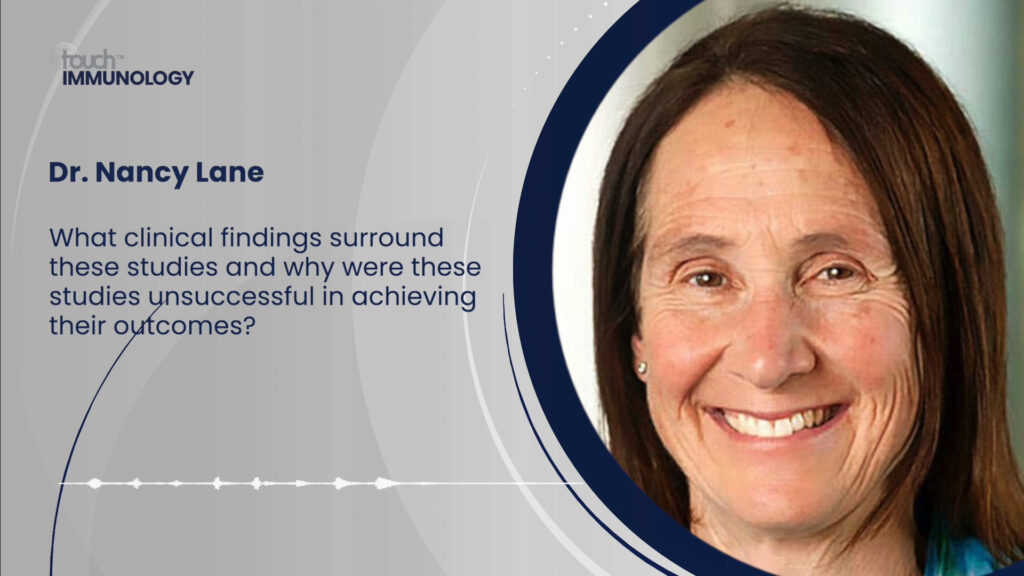The COLOR trial is a single-centre, double-blind, randomised, placebo-controlled trial that aimed to investigate colchicine’s efficacy and safety compared with placebo in people with hand osteoarthritis. touchIMMUNOLOGY were delighted to speak with Dr Anna Døssing (The Parker Institute, University of Copenhagen Copenhagen, Denmark) about the findings of the COLOR trial and what further investigation is needed.
The abstract ‘Colchicine twice daily for hand osteoarthritis: results from the double-blind, randomised, placebo-controlled COLOR trial‘ was presented at the European Alliance of Associations for Rheumatology (EULAR), 31 May – 03 June 2023.
Questions
- What is the rationale for using colchicine in the treatment of hand osteoarthritis when previous evidence is contradictory? (0:18)
- What are the aims, design, and findings of the COLOR trial? (1:22)
- Why was the primary endpoint not achieved and what further studies are needed? (3:25)
Disclosures: Anna Døssing has nothing to disclose in relation to this video interview.
Support: Interview and filming supported by Touch Medical Media Ltd. Interview conducted by Shanice Allen.
Filmed in coverage of the European Alliance of Associations for Rheumatology (EULAR) Annual Meeting
Click here for more content from EULAR.
Transcript
Hi. My name is Anna Døssing. I’m a medical doctor from Copenhagen Denmark I’m training as a rheumatologist.
What is the rationale for using colchicine in the treatment of hand osteoarthritis when previous evidence is contradictory?
The rationale for using colchicine is really centered around the suggested role of crystals in osteoarthritis. And we know that stimulating cells with colchicine inhibits interleukin 1 beta maturation on the suggested mechanism of action in gout and pseudogout. Now having numerous trials on colchicine with divergent results, it is important to establish whether it is an actual effect or not. And looking at the previous trials, colchicine has been administered differently as an add-on to other therapies. And also the population, you may say “oh, someone, he’s —” so you will have somewhere, you can have a discussion on whether it is away or whether it might actually be, in fact, be a crystal deposition disease that is treated. There’s only been one study in hand OA and it, regardless of whether you have a positive or negative finding, it is always important to substantiate what the result is.
What are the aims, design, and findings of the COLOR trial?
So the COLOR trial was a randomized, double-blind control trial of colchicine, 0.5 milligrams, twice a day for 12 weeks compared to placebo. We included people with painful hand osteoarthritis, so they had to have a visual analogue scale pain of 40 on a numerical or on a visual analogue scale of 0 to 100, and they could have no other rheumatic diseases or diseases causing pain in the hands. And so they’re randomized one to one to treatment on colchicine or placebo. And we had the primary endpoint after 12 weeks. So the primary outcome was to assess change in visual analogue scale finger pain from baseline to week 12. And the aim was to discover whether colchicine might be able to reduce pain in people with hand OA compared to placebo. So we hypothesized that it would be effective in reducing pain and turned out to not be the case. So the primary outcome, what is important to know, is that we separated measures from the left and right hand, we selected a target hand, which was the hand where the patient had the most severe hand pain. And then we measured separately on the thumb and the fingers. So the primary outcome was finger pain in the target hand. And the change from baseline in the colchicine group on a visual analogue scale was -13.9, which was nice, but it was, we had a cut off for clinical reporting different of 15. It did not achieve that. And looking at the response in the placebo arm, this was -13.5. So we have two almost identical treatment responses in the colchicine and in the placebo arm. So what we found was that colchicine is no better than placebo in reducing pain for people with hand OA when taken two times a day for 12 weeks.
Why was the primary endpoint not achieved and what further studies are needed?
So it is always difficult when you have a negative trial, that can be multiple reasons. In this case, we did have a very narrow confidence interval around the between group difference. So having a negative trial, I think one of the why we had it well, of course, it could be that colchicine taken two times a day for 12 weeks simply is not effective for hand OA. Now there has been a — going around in colchicine. Just recently, they were published some data from a study on chronic heart diseases where colchicine was taken one tablet a day for a long period of time. And we saw that the use of colchicine was associated to the incidence of total knee replacement and total hip replacements. Then the median follow-up time in this study was around 28 months. So this suggests that if colchicine were to be effective, we may need to take it for a longer period of time than the 12 weeks. We have also seen another hand OA trial that studies structural modifying abilities, the trial of denosumab. It didn’t find, it did find structural modifying abilities early on, but it took two years before they could register any differences in patient reported outcomes. So if we are to investigate this further, treatment duration, may be something we need to address. And also, when we talk about hand OA, we do have a very huge gene population. We have those people with erosive hand OA, inflammatory hand OA, and we may be looking more into subgroups when treating going forward.
Subtitles and transcript are autogenerated.









